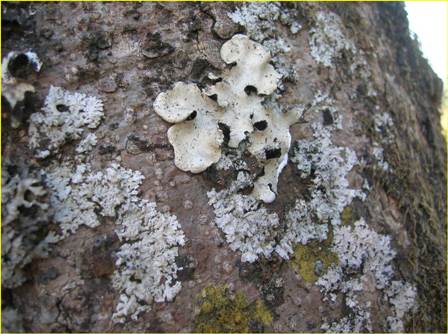 Lichens:
Lichens:
A lichen is a composite organism that arises from algae or cyanobacteria (or both) living among filaments of a fungus in a symbiotic relationship.[1][2][3] The combined life form has properties that are very different from the properties of its component organisms. Lichens come in many colors, sizes, and forms. The properties are sometimes plant-like, but lichens are not plants. Lichens may have tiny, leafless branches (fruticose), flat leaf-like structures (foliose), flakes that lie on the surface like peeling paint (crustose),[4] or other growth forms.[5]A macrolichen is a lichen that is either bush-like or leafy; all other lichens are termed microlichens.[1] Here, "macro" and "micro" do not refer to size, but to the growth form.[1] Common names for lichens may contain the word "moss" (e.g., "Reindeer moss", "Iceland moss"), and lichens may superficially look like and grow with mosses, but lichens are not related to mosses or any plant.[3]:3 Lichens do not have roots that absorb water and nutrients as plants do[6]:2 but like plants they produce their own food by photosynthesis using sunlight energy, from carbon dioxide, water and minerals in their environment.[7] When they grow on plants, they do not live as parasites and only use the plants as a substrate.
Lichens occur from sea level to high alpine elevations, in a very wide range of environmental conditions, and can grow on almost any surface.[7] Lichens are abundant growing on bark, leaves, mosses, on other lichens,[6] and hanging from branches "living on thin air" (epiphytes) in rain forests and in temperate woodland. They grow on bare rock, walls, gravestones, roofs, exposed soil surfaces, and in the soil as part of a biological soil crust. Different kinds of lichens have adapted to survive in some of the most extreme environments on Earth: arctic tundra, hot dry deserts, rocky coasts, and toxic slag heaps. They can even live inside solid rock, growing between the grains. Some lichens do not grow on anything, living out their lives blowing about the environment.[1] It is estimated that 6% of Earth's land surface is covered by lichen.[8] Colonies of lichens may be spectacular in appearance, dominating much of the surface of the visual landscape in forests and natural places, such as the vertical "paint" covering the vast rock faces of Yosemite National Park.[9]:2
The fungus benefits from the symbiotic relation because algae or cyanobacteria produce food by photosynthesis. The algae or cyanobacteria benefit by being protected from the environment by the filaments of the fungus, which also gather moisture and nutrients from the environment, and (usually) provide an anchor to it. Lichenized fungus may refer to the entire lichen, or to the fungus growing in it. The lichen combination of fungus with algae and/or cyanobacteria has a very different form (morphology), physiology, and biochemistryto the component parts growing by themselves. Lichens are said to be "species", but what is meant by "species" is different from what is meant for plants, animals, and fungi, for which "species" implies a common ancestral lineage. Lichens are really combinations of species from two or three different biological kingdoms, so there is no common lineage. By convention, lichens have the same scientific name as the fungus in them, and are not classified according to the species of the algae and/or cyanobacteria growing in them. The alga or cyanobacterium has its own, unique, scientific name (binomial name). There are about 20,000 known species of lichens.[10] Some lichenshave lost the ability to reproduce sexually, yet continue to speciate.[6][11] Recent perspectives on lichens include that they are relatively self-contained miniature ecosystems in and of themselves, possibly with more microorganisms living with the fungi, algae, and/or cyanobacteria, performing other functions as partners in a system that evolves as an even more complex composite organism (holobiont).[12][13][14][15] In Auugst 2016, it was reported that macrolichens have more than one species of fungus in their tissues.[16][17]
Lichens may be long-lived, with some considered to be among the oldest living things.[3][18] They are among the first living things to grow on fresh rock exposed after an event such as a landslide. The long life-span and slow and regular growth rate of some lichens can be used to date events (lichenometry). Many lichens are very sensitive to environmental disturbances and can be used in cheaply[7]assessing air pollution,[19][20][21] ozone depletion, and metal contamination. Lichens have been used in making dyes, perfumes,[22] and intraditional medicines. Few lichen species are eaten by insects[7] or larger animals, such as reindeer.[23] (Wikipedia 2016)
 Common groupings of lichen thallus growth forms are:
1. fruticose[29][30] – growing up like a tuft or multiply branched leafless mini-shrub, or hanging down in strands or tassles, 3-dimensional with a nearly round cross section for its branching parts (terete)
2. foliose[29][30] – growing in 2-dimensional, flat, leaf-like lobes that lift up from the surface
3. crustose[4][29][30] – crust-like, adhering tightly to a surface (substrate) like a thick coat of paint
4. leprose[31] – powdery
5. gelatinous – jelly like
6. filamentous – stringy or like matted hair
7. byssoid – wispy, like teased wool
8. structureless.
(Wikipedia 2016)
Common groupings of lichen thallus growth forms are:
1. fruticose[29][30] – growing up like a tuft or multiply branched leafless mini-shrub, or hanging down in strands or tassles, 3-dimensional with a nearly round cross section for its branching parts (terete)
2. foliose[29][30] – growing in 2-dimensional, flat, leaf-like lobes that lift up from the surface
3. crustose[4][29][30] – crust-like, adhering tightly to a surface (substrate) like a thick coat of paint
4. leprose[31] – powdery
5. gelatinous – jelly like
6. filamentous – stringy or like matted hair
7. byssoid – wispy, like teased wool
8. structureless.
(Wikipedia 2016)
Dedicated to:
 |
|
|
|
|  |
|
|
|
 |
|
|
|
 |
|
|
|
 |
| Dr. P. G. Patwardhan |
|
|
|
| Dr. D. D. Awasthi |
|
|
|
Dr. D. K. Upreti |
|
|
|
Dr. Ajay Singh |
|
|
|
Dr. K. P. Singh |
About Database
The Indian Lichens Database (ILD) is a simple reference database.
Beinig a database of references, the structure of this relational database is very simple and easy to use.
Each record in the database has a unique identification number. For example, 'UID123' stands for 'Unique Identification number 123'. In addition to this identification number there is another identification number which uniquely identifies individual species. This number is called 'IMD' number. This number is useful since there can be more than one references to a single individual species. For example, there are two records for Abortiporus biennis. Thus this record has two UIDs, viz. UID99 and UID729. But the species has single unique ILD number.
1. Search : Users can build simple as well as complex queries. The search results are alphabettically arranged according to generic and specific names. The IMD numbers are also given in the search results.
2. Browse : Database can be browsed by three hierarchical catagories viz. Family, Genus and Species. In addition to this, all records can also be browsed at a time. The number of sub entries are shown at each level of browsing.
Above two options allow the users to query the database in varied ways.
All information of a particular record can be viewed in a card viewer which opens in the same page by clicking on a name in the search/browse result.
The Indian Lichens Database (ILD) has been linked to MycoBank.
Database Management System : MySQL 5.0
Server : Apache 2.2
Server side script : PHP
Cleint side script : javascript
All the web pages of this site are successfully tested on Mozilla Firefox 3.5.6.
(Get Mozilla Firefox)
Myxomycetous Photogallery
Work in progress!
Education
Work in progress!
DIV 4
|
| Introduction |
| About Database |
| Photogallery |
| Education |
Database statistics
| Number of Families | : | 85 | | Number of Genus | : | 348 | | Total number of Species | : | 2438 | | Total number of records | : | 3089 |
|

